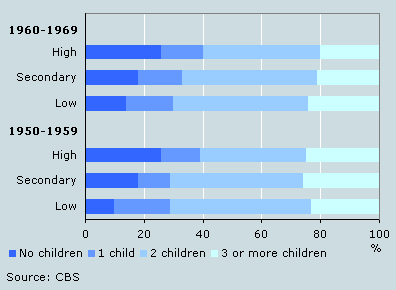Fewer women, fewer children

Last year, 185 thousand children were born in the Netherlands, an increase by 20 thousand compared to 2000. The decline in recent years is mainly due to the fact that there are fewer women of child-bearing age.
Number of births reduced further
In the years to come the number of births will decline further, because the number of women of fertile age will continue to fall. This is the result of a significant reduction in female births in the 1970s.
Number of live births

Average number of children stable
Although the overall number of women declines, the fertility rate hardly changes. The fertility rate of women born after 1950 who are no longer reproductive ranges between 1.8 and 1.9. Statistics Netherlands expects the fertility rate of the current generation of young women to be 1.8.
Over 40 percent of women got two children. One in four women born after 1945 have three or more children. It is expected that one in five women of the younger generations will have three or more children.
Women by year of birth and number of children

One in five women remain childless
Over 10 percent of women who are now in their late 60s and early 70s have no children. For women around the age of 50, the childless rate is 15 percent. Approximately one fifth of women belonging to the younger generations are expected to remain childless.
Highly educated women more often childless
Highly educated women more often remain childless. One quarter of highly educated women born in the 1950s remained childless, as opposed to 10 percent of low-educated women. The difference is somewhat smaller for women born in the 1960s.
Women by birth period, number of children and education level

The childless rate for highly educated women is higher, because they more often do not maintain a stable relationship. Part of the highly educated women born in the 1950s preferred to pursue a career instead of being a mother.
Arie de Graaf